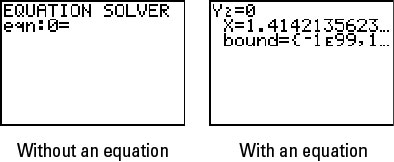

We use two versions of the ideal gas constant, 'Rg' and 'R', so that we can have one ideal gas constant (Rg) in units of L-atm/mol-K and one (R) in terms of Joules/mol-K. Note that we use 'mol' instead of 'n' in the ideal gas law because 'n' is not allowed as a variable on some calculators. You will not have to enter them again for the life of the calculator. This is a bit of a pain, as you have to be careful to use the key (for uppercase) and keys (for lowercase).īut the payoff will be worth the trouble, because once these equations are in your calculator, To get started, enter the following with upper/lower case exactly as shown below. You can enter those equations into your TI calculator. See also examples involving equilibrium and Boltzmann distributionĪnother web page you might be interested in is Make sure you read the section corresponding to your calculator. Note, the TI-89 makes no distinction between upper and lower case. TI-85 or TI-86 prior to each letter, then the key for that letter With the TI-89, these will be lowercase.Į q n (lowercase letters) press on the TI-89 or on the IDEAL (uppercase letters) press prior to each letter, There is a similar chapter for the TI-89.

If you have a TI-85 or TI-86, you might want to check out the complete chapter Solving systems of equations is a very general and important idea, and one that is fundamental in many areas of mathematics, engineering and science.Using Your TI-85, TI-86, or TI-89 Equation Solver Using Your TI-85, Going further, more general systems of constraints are possible, such as ones that involve inequalities or have requirements that certain variables be integers. These possess more complicated solution sets involving one, zero, infinite or any number of solutions, but work similarly to linear systems in that their solutions are the points satisfying all equations involved. More general systems involving nonlinear functions are possible as well. Systems of linear equations involving more than two variables work similarly, having either one solution, no solutions or infinite solutions (the latter in the case that all component equations are equivalent). The system is said to be inconsistent otherwise, having no solutions. If all lines converge to a common point, the system is said to be consistent and has a solution at this point of intersection. In the case of two variables, these systems can be thought of as lines drawn in two-dimensional space. Systems of linear equations are a common and applicable subset of systems of equations. To solve a system is to find all such common solutions or points of intersection. The solutions to systems of equations are the variable mappings such that all component equations are satisfied-in other words, the locations at which all of these equations intersect. What are systems of equations? A system of equations is a set of one or more equations involving a number of variables. Partial Fraction Decomposition Calculator.
#SYSTEM OF EQUATIONS SOLVER TI 89 GENERATOR#
Get immediate feedback and guidance with step-by-step solutions and Wolfram Problem Generator
#SYSTEM OF EQUATIONS SOLVER TI 89 HOW TO#
Here are some examples illustrating how to ask about solving systems of equations.

To avoid ambiguous queries, make sure to use parentheses where necessary. Additionally, it can solve systems involving inequalities and more general constraints.Įnter your queries using plain English. It can solve systems of linear equations or systems involving nonlinear equations, and it can search specifically for integer solutions or solutions over another domain. Wolfram|Alpha is capable of solving a wide variety of systems of equations. Equation 4: Compute A powerful tool for finding solutions to systems of equations and constraints


 0 kommentar(er)
0 kommentar(er)
